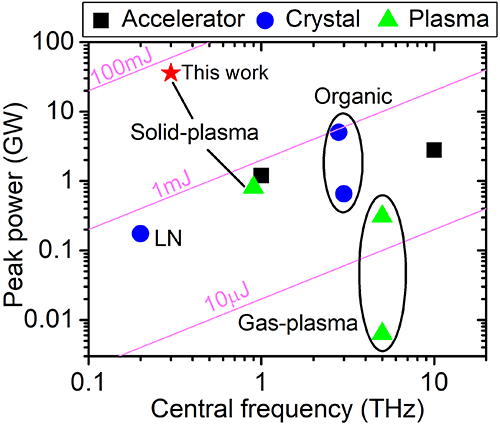
Electromagnetic waves between infrared and microwaves are called as Terahertz (THz) radiation. It is a big challenge to generate intense THz radiation, which is significantly important for THz sciences and applications in many interdisciplinary fields.
Although THz sources have been generated with electronic and optical techniques for the last decades, the THz pulse energy reported is lower than a millijoule.
Results recently published in PNAS show that strong terahertz bursts with tens millijoules of energy, a world record for laboratory sources, can be obtained using high-power lasers.
Prof. LI Yutong's groups from Institute of Physics, Chinese Academy of Sciences, Prof. ZHANG Jie's group from Shanghai Jiaotong University, in collaboration with Prof. David Neely from Central Laser Facility, STFC Rutherford Appleton Laboratory, Prof. Paul McKenna from University of Strathclyde, and UK scientists from the University of York have studied THz radiation from intense laser-metal foil interactions.
Using the Vulcan laser at the Central Laser Facility, the record for the highest energy in a single pulse of terahertz radiation has been achieved in the laboratory.
The generation of such a strong THz source is mainly due to the coherent transition radiation when an energetic electron bunch crossing the rear surface of the thin foil. The electron bunch with high charge is accelerated by the high intensity laser pulses in the mm-sized solid metal foil.
Terahertz are already used in tech in many fields. For example, the full body scanners for airport security check. The powerful THz source driven by high power lasers provides opportunities to look at nonlinear dynamics in matter.
This study entitled "Multi-millijoule coherent terahertz bursts from picosecond laser-irradiated metal foils" was published on PNAS.
The study was supported by the National Science Foundation, the Ministry of Science and Technology of China, the Chinese Academy of Sciences, National Postdoctoral Program for Innovative Talents, Newton and Engineering and Physical Sciences Research Council of UK.

Fig.1 Comparison of currently available high-peak-power THz sources. The data are referenced from previously reported typical results of THz sources based on conventional accelerators (black squares), optical rectification from crystals (blue circles) like lithium niobate (LN) and organic crystals, and gas/solid-density plasmas (green triangles). The red star represents the data presented in this paper. Magenta curves represent different energy ranges for half-cycle THz pulses. (Image by Institute of Physics)
Related link: Record result for T-ray pulse energy obtained in a laboratory so far using Vulcan laser

86-10-68597521 (day)
86-10-68597289 (night)

52 Sanlihe Rd., Xicheng District,
Beijing, China (100864)

